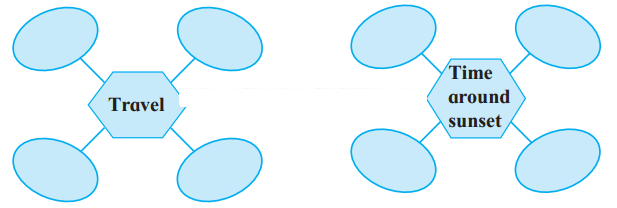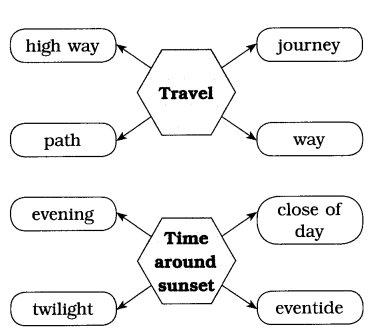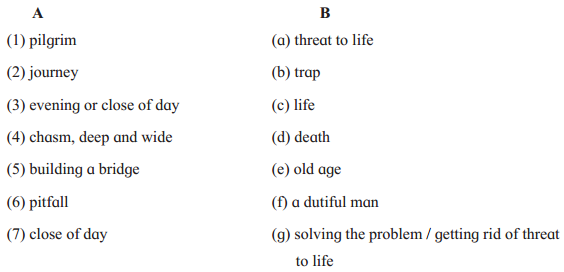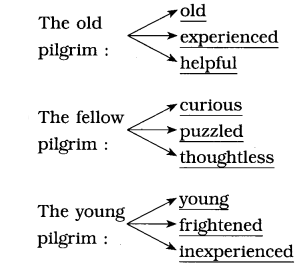Balbharti Maharashtra State Board Class 8 English Solutions Chapter 1.3 The Pilgrim Notes, Textbook Exercise Important Questions and Answers.
Class 8 English Chapter 1.3 The Pilgrim Textbook Questions and Answers
Warming Up:
Make groups and discuss the following using the given points:
Question a.
What fatal dangers/problems did mankind face centuries ago, but are no longer a threat today?
Answer:
(Points : wild animals – lack of food – certain diseases – climate etc.)
Question b.
Name a few scientists/explorers/ social reformers / inventors / discoverers, who spent most of their lives to find solutions to some major problems/ setbacks that mankind faced.
Answer:
(Points : Alexander Fleming, Edison, Ronald Ross, Christopher Columbus, Wright brothers, Raja Ram Mohan Roy, Galileo, Marie Curie, Savitribai Phule, Babasaheb Ambedkar, etc.)
Question c.
Did they themselves suffer from those problems/setbacks?
Answer:
(Points : most did not)
Question d.
What inspired them to spend the best part of their lives to research and share their findings?
Answer:
(Points : a passion for well-being of ! mankind – personal goals and aims – interest in the subject – curiosity – the urge to improve society and help others – etc.)
2. Read and understand the following poetic devices:
(A) If two or more words in the same line convey the some meaning, the Figure of Speech in thut line is called Tautology.
For example: It brought joy and cheer.
They groaned with aches and pains.
(B) ‘Poets often change the proper grammatical order of words in the ¡inc of a poem, in order to make the lines rhyme or to emphasize upon something. The Figure of Speech in such lines is called inersion’ or Anastrophe.’
For example: Up came the sun. Down the hill, it flowed.
(C) When a question is asked in order to create a dramatic effect and not to get an answer, in a line of the poem, the Figure of Speech used is called
Interrogation / Rhetorical Questions:
For example: What is this life, if full of care?
When can their glory fade?
1.Pick out words from the poem to fill in the web diagram. They should be related to the theme in the web.

Answer:

2.The entire poem is metaphorical (Implied comparison).
Match the words in Column A with what they imply in Column B.

Answer:
(1) pilgrim – a dutiful man
(2) journey – life
(3) evening or close of day – old age
(4) chasm, deep and wide – threat to life
(5) building a bridge – solving a problem /getting rid of a threat to life
(6) pitfall – trap
(7) close of day – death
3. A. Read the poem and write 3 qualities of each of the following.

Answer:

3. B. Answer in your own words.
Question a.
Why did the old man have no need to build the bridge, across the chasm?
Answer:
The old pilgrim had already crossed the chasm and would never pass that way again. Hence, the old man had no need to build the bridge across the chasm.
Question b.
What explanation did he give to the fellow- pilgrim for his thoughtful deed?
Answer:
The old man said that though he had already crossed the chasm, there was a fair-haired youth who was about to pass that way. The old man was experienced and was not afraid of the chasm. However, the young man was inexperienced and the chasm could prove to be a pitfall for him.
He too had to cross it at twilight, and the old man was building a bridge to help this youth.
Question c.
What message does the poem convey to all of us?
Answer:
The message that the poem conveys to us is that we must be generous ) and unselfish and think of others. We must try to help others who are not as experienced as we are.
4. A. Note the rhyming words in the first stanza:
way – gray I wide-side- tide / dim -him.
Poet has used a deliberate pattern of lines that rhyme with other lines in the poem or
the stanza. This pattern can be identified by giving the rhyming pairs of words the
same letter of the alphabet.
For example: l stanza of this poem has the pattern AABCCBB
So, AABCCBB is called the Rhyme Scheme of the 1stanza of the poem
‘The Pilgrim’.
Answer:
(i) the 2nd stanza : ddaabb
(ii) the 3rd stanza: eeaaffcc
4. B. Now write the Rhyme Scheme of the 2stanza and 3 stanza
Remember that a line in the 2d or stanza may rhyme with lines in P’ stanza,
too. You may use the sanie letter of the alphabet as used in the 1 stanza.
Answer:
(i) Came at evening, cold and gray. To a chasm, deep and vast and wide.
(The correct prose order Is: Came on a cold and gray evening to a deep and wide and vast chasm.)
(ii) To the fair-haired youth. may a pitfall be.
(The correct prose order is : To the fair-haired youth, It may be a pitfall.)
4. C. Find two lines from the poem that j contain the figure of speech ‘Inversion’.
Answer:
(i) Came at evening, cold and gray, To a chasm, deep and vast and wide.
(The correct prose order is : Came on j a cold and gray evening to a deep and wide and vast chasm.)
(ii) To the fair-haired youth, may a pitfall be.
(The correct prose order is : To the fair-haired youth, it may be a pitfall.)
Pick out one line each that contains the following figures of speech:
(Note: Refer to the next page for the explanation.)
Question a.
Tautology:
Answer:
To a chasm, deep and vast and wide.
The words vast and wide have similar meaning.
Question b.
Personification:
Answer:
A pilgrim, going a lone highway.
The highway is given the human quality of being lonely.
Question c.
Interrogation:
Answer:
Why waste your time in building here?
A question is asked to emphasize an idea.
5. Imagine that you are the fellow – pilgrim and you wish to share your experience of the incident in the poem. Write a short article about it for a magazine / journal. Also convey what change it has brought in our life.
Class 8 English Chapter 1.3 The Pilgrim Additional Important Questions and Answers
Complete the following:
Question 1.
Although he had already crossed the chasm, the pilgrim ________.
Answer:
paused and built a bridge across the waters.
Question 2.
The old pilgrim built the bridge to to __________.
Answer:
help the Inexperienced youth who was following on the same path.
Complex Factual Activities:
Give reasons:
Question a.
The fellow pilgrim was puzzled.
Answer:
The old pilgrim had already crossed the chasm and would never pass that way again. Yet, he was building a bridge across the chasm. The fellow pilgrim could not understand the reason for this and was hence puzzled.
Question b.
What/Who could be the third pilgrim?
Answer:
The third pilgrim could be a young, inexperienced youth.
Analysis/Appreciation Of A Poem
Answer:
(1) Poem and poet: ‘The Pilgrim’ by Will Allan Dromgoole
(2) Theme: Those who have faced the difficulties of life successfully and are experienced must be unselfish and help those who are inexperienced and may face difficulties.
(3) Tone: Serious.
(4) Structure and stanzas: Stanzas of unequal length; 1st stanza – 7 lines; 2nd stanza – 6 lines; 3rd stanza – 8 lines;
(5) Rhyme and Rhythm: 1st stanza – AABCCBB; 2nd stanza – ddaabb; 3rd stanza – eeaaffcc
(6) Language and Imagery: The narrative is direct with some archaic language used; there is a strong underlying message. The descriptions are vivid.
(7) Figures of Speech: Inversion, Tautology, Personification, Interrogation.
Writing Skills:
“Imagine that you are the fellow-pilgrim and you wish to share your experience of \ the incident in the poem. Write a short j article about it for a magazine/journal.
Also convey what change it has brought in your life.
Answer:
The Turning Point
There are certain incidents in one’s life which have an impact on a person and prove to be a turning point in their lives. Let me narrate the incident which shook me awake.
I was on a hike in some hilly places when I had to cross a deep ravine which had a gushing river flowing through it. I managed to cross without any difficulty to my surprise, an old man ahead of me also crossed it nimbly. As I was about to continue on my way, I saw the old man turn back and build a rough bridge across the water. It took a lot of effort and I stood by wondering. Finally, I asked him, “Sir, it is late evening and you Eire not likely to cross this way again. Why are you building a bridge now?”
The old man’s answer floored me. “You confused child,” he said with a smile. “I have completed my journey – true. But behind me is a young boy who is inexperienced.
He will soon reach this chasm, and he may have difficulty in crossing it. I am building this bridge to help him.”
I stood still, amazed at the generosity and unselfishness of the old man, who was putting in the time and effort to help someone he did not even know. He was building a bridge that he would never ever cross.
This incident left an indelible mark on my mind. Since that time, I always try to help others even though it may not be beneficial to me in any way. However, it gives me something immeasurable – peace and happiness. Try it out, won’t you? (indelible – permanent; unfading)